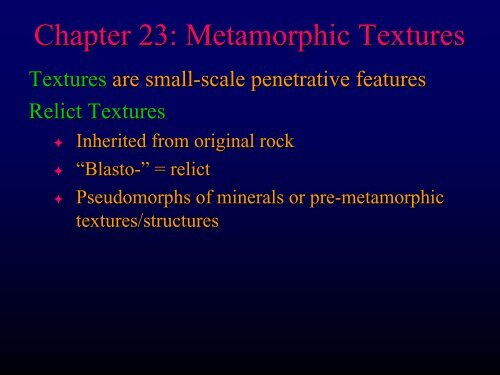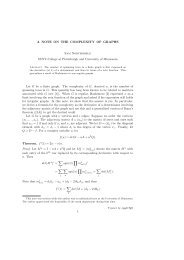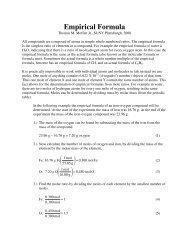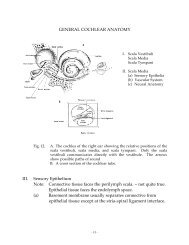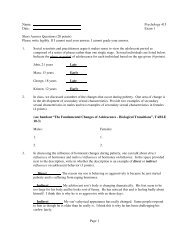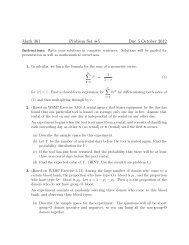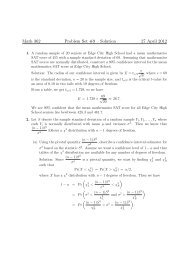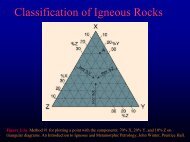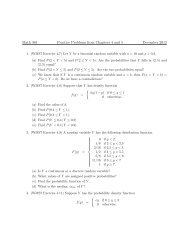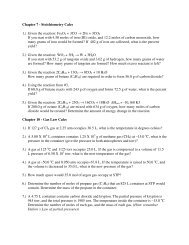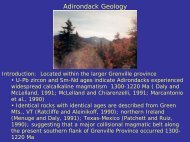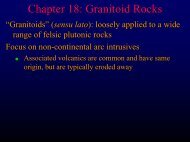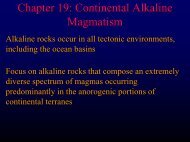Chapter 23: Metamorphic Textures - Faculty web pages
Chapter 23: Metamorphic Textures - Faculty web pages
Chapter 23: Metamorphic Textures - Faculty web pages
Create successful ePaper yourself
Turn your PDF publications into a flip-book with our unique Google optimized e-Paper software.
<strong>Chapter</strong> <strong>23</strong>: <strong>Metamorphic</strong> <strong>Textures</strong><br />
<strong>Textures</strong> are small-scale scale penetrative features<br />
Relict <strong>Textures</strong><br />
<br />
<br />
<br />
Inherited from original rock<br />
“Blasto-” = relict<br />
Pseudomorphs of minerals or pre-metamorphic<br />
textures/structures
<strong>Chapter</strong> <strong>23</strong>: <strong>Metamorphic</strong> <strong>Textures</strong><br />
The Processes of Deformation, Recovery, and<br />
Recrystallization<br />
1. Cataclastic Flow<br />
Mechanical fragmentation and sliding,<br />
rotation of fragments<br />
Bending, kinking, deformation twins,<br />
undulose extinction<br />
Technically not metamorphic
<strong>Chapter</strong> <strong>23</strong>: <strong>Metamorphic</strong> <strong>Textures</strong><br />
2. Pressure Solution<br />
c. Pressure solution of a quartz crystal<br />
in a deformed quartzite (σ 1<br />
is vertical).<br />
Pressure solution results in a serrated<br />
solution surface in high-strain areas<br />
(small arrows) and precipitation in lowstrain<br />
areas (large arrow). ~ 0.5 mm<br />
across.<br />
Figure <strong>23</strong>-2 a. Highest strain in areas near<br />
grain contacts (hatch pattern).<br />
b. High-strain areas dissolve and material<br />
precipitates in adjacent low-strain areas<br />
(shaded).<br />
The process is accompanied by vertical<br />
shortening.<br />
.After Hibbard (1995) Petrography to Petrogenesis. Prentice Hall.
<strong>Chapter</strong> <strong>23</strong>: <strong>Metamorphic</strong> <strong>Textures</strong><br />
3. Plastic Intracrystalline Deformation<br />
No loss of cohesion<br />
Several processes may operate simultaneously<br />
Defect migration<br />
Slip planes<br />
Dislocation glide<br />
Deformation twinning
<strong>Chapter</strong> <strong>23</strong>: <strong>Metamorphic</strong> <strong>Textures</strong><br />
4. Recovery<br />
Loss of stored strain energy by vacancy<br />
migration, dislocation migration and<br />
dislocation annihilation<br />
Formation of low-strain subgrains
<strong>Chapter</strong> <strong>23</strong>: <strong>Metamorphic</strong> <strong>Textures</strong><br />
Recovery = dislocation migration to form two<br />
strain-free subgrains<br />
Figure <strong>23</strong>-5. Illustration of a recovery<br />
process in which dislocations migrate to<br />
form a subgrain boundary. Winter (2001) An<br />
Introduction to Igneous and <strong>Metamorphic</strong> Petrology.<br />
Prentice Hall.
<strong>Chapter</strong> <strong>23</strong>: <strong>Metamorphic</strong> <strong>Textures</strong><br />
a. Undulose extinction in<br />
quartz<br />
b. Elongate subgrains in quartz<br />
due to dislocation formation and<br />
migration<br />
Figure <strong>23</strong>-4 Winter (2001) An Introduction to Igneous and <strong>Metamorphic</strong> Petrology. Prentice Hall.
<strong>Chapter</strong> <strong>23</strong>: <strong>Metamorphic</strong> <strong>Textures</strong><br />
5. Recrystallization<br />
Grain boundary migration<br />
Subgrain rotation<br />
Solid-state diffusion creep at higher T<br />
Crystal-plastic deformation<br />
Grain boundary sliding and area reduction
Recrystallization:<br />
Grain Boundary<br />
Migration - recovery<br />
and recrystallization<br />
by which large grains<br />
form by the addition<br />
of smaller strained<br />
grains<br />
Sub-grain rotation<br />
Figure <strong>23</strong>-6. Recrystallization by<br />
(a) grain-boundary migration<br />
(including nucleation) and<br />
(b) subgrain rotation. From Passchier<br />
and Trouw (1996) Microtectonics. Springer-<br />
Verlag. Berlin.
Recrystallization by grain<br />
boundary migration and<br />
sub-grain rotation<br />
Figure <strong>23</strong>-7a. Recrystallized quartz<br />
with irregular (sutured) boundaries,<br />
formed by grain boundary migration.
Differences in development of crystal<br />
form among some metamorphic<br />
minerals. From Best (1982). Igneous and<br />
<strong>Metamorphic</strong> Petrology. W. H. Freeman. San Francisco.<br />
The Crystalloblastic Series<br />
Most Euhedral<br />
Titanite, rutile, pyrite, spinel<br />
Garnet, sillimanite, staurolite,<br />
tourmaline<br />
Epidote, magnetite, ilmenite<br />
Andalusite, pyroxene, amphibole<br />
Mica, chlorite, dolomite, kyanite<br />
Calcite, vesuvianite, scapolite<br />
Feldspar, quartz, cordierite<br />
Least Euhedral
<strong>Metamorphic</strong> <strong>Textures</strong><br />
<strong>Textures</strong> of Regional Metamorphism<br />
Dynamothermal (crystallization under dynamic<br />
conditions)<br />
Orogeny- long-term mountain-building<br />
May comprise<br />
several Tectonic Events<br />
several Deformational Phases<br />
May have an accompanying <strong>Metamorphic</strong> Cycles with<br />
one or more Reaction Events
<strong>Metamorphic</strong> <strong>Textures</strong><br />
<strong>Textures</strong> of Regional Metamorphism<br />
Tectonite- a deformed rock with a texture that<br />
records the deformation<br />
Fabric- the complete spatial and geometric<br />
configuration of textural elements
Progressive<br />
syntectonic<br />
metamorphism of a<br />
volcanic graywacke,<br />
New Zealand. From<br />
Best (1982). Igneous and<br />
<strong>Metamorphic</strong> Petrology. W. H.<br />
Freeman. San Francisco.
Fig <strong>23</strong>-21 21 Types of foliations<br />
a. Compositional layering<br />
b. Preferred orientation of<br />
platy minerals<br />
c. Shape of deformed grains<br />
d. Grain size variation<br />
Figure <strong>23</strong>-21. Types of fabric elements that may<br />
define a foliation. From Turner and Weiss (1963) and Passchier<br />
and Trouw (1996).
a<br />
b<br />
Figure <strong>23</strong>-<strong>23</strong>. Continuous<br />
schistosity developed by<br />
dynamic recrystallization of<br />
biotite, muscovite, and quartz. a.<br />
Plane-polarized light, width of field 1 mm. b.<br />
Crossed-polars, width of field 2 mm. Although<br />
there is a definite foliation in both samples, the<br />
minerals are entirely strain-free.
Progressive development (a → c) of a<br />
crenulation cleavage for both<br />
asymmetric (top) and symmetric<br />
(bottom) situations. From Spry (1969)<br />
<strong>Metamorphic</strong> <strong>Textures</strong>. Pergamon. Oxford.
Figure <strong>23</strong>-24a. Symmetrical crenulation cleavages in amphibole-quartz-rich schist. Note<br />
concentration of quartz in hinge areas. From Borradaile et al. (1982) Atlas of Deformational and <strong>Metamorphic</strong> Rock<br />
Fabrics. Springer-Verlag.
Figure <strong>23</strong>-24b. Asymmetric crenulation cleavages in mica-quartz-rich schist. Note horizontal<br />
compositional layering (relict bedding) and preferential dissolution of quartz from one limb of the<br />
folds. From Borradaile et al. (1982) Atlas of Deformational and <strong>Metamorphic</strong> Rock Fabrics. Springer-Verlag.
Types of lineations<br />
a. Preferred orientation<br />
of elongated<br />
mineral aggregates<br />
b. Preferred<br />
orientation of<br />
elongate minerals<br />
c. Lineation defined by<br />
platy minerals<br />
d. Fold axes<br />
(especially of<br />
crenulations)<br />
Figure <strong>23</strong>-26. Types of fabric elements that<br />
define a lineation. From Turner and Weiss (1963)<br />
Structural Analysis of <strong>Metamorphic</strong> Tectonites. McGraw Hill.
Development of an axial-planar cleavage in folded<br />
metasediments. Circular images are microscopic<br />
views showing that the axial-planar cleavage is a<br />
crenulation cleavage, and is developed<br />
preferentially in the micaceous layers. From Gilluly,<br />
Waters and Woodford (1959) Principles of Geology, W.H. Freeman;<br />
and Best (1982). Igneous and <strong>Metamorphic</strong> Petrology. W. H.<br />
Freeman. San Francisco.
Pre-kinematic<br />
crystals<br />
a. Bent crystal with<br />
undulose<br />
extinction<br />
b. Foliation<br />
wrapped around<br />
a porphyroblast<br />
c. Pressure shadow<br />
or fringe<br />
d. Kink bands or<br />
folds<br />
e. Microboudinage<br />
f. Deformation<br />
twins<br />
Figure <strong>23</strong>-34. Typical textures of prekinematic<br />
crystals. From Spry (1969)<br />
<strong>Metamorphic</strong> <strong>Textures</strong>. Pergamon.<br />
Oxford.
Post-kinematic crystals<br />
a. Helicitic folds b. Randomly oriented crystals c. Polygonal arcs<br />
d. Chiastolite e. Late, inclusion-free rim on a poikiloblast<br />
f. Random aggregate pseudomorph<br />
Figure <strong>23</strong>-<br />
35. Typical<br />
textures of<br />
postkinematic<br />
crystals. From<br />
Spry (1969)<br />
<strong>Metamorphic</strong><br />
<strong>Textures</strong>.<br />
Pergamon.<br />
Oxford.
Syn-kinematic crystals<br />
Spiral Porphyroblast<br />
Figure <strong>23</strong>-38. Traditional interpretation of spiral S i<br />
train<br />
in which a porphyroblast is rotated by shear as it grows.<br />
From Spry (1969) <strong>Metamorphic</strong> <strong>Textures</strong>. Pergamon. Oxford.
Syn-kinematic crystals<br />
Figure <strong>23</strong>-38.<br />
Spiral S i<br />
train in<br />
garnet, Connemara,<br />
Ireland. Magnification<br />
~20X. From Yardley et<br />
al. (1990) Atlas of<br />
<strong>Metamorphic</strong> Rocks and<br />
their <strong>Textures</strong>.<br />
Longmans.
Syn-kinematic crystals<br />
Figure <strong>23</strong>-38.<br />
“Snowball<br />
garnet” with<br />
highly rotated<br />
spiral S i<br />
.<br />
Porphyroblast<br />
is ~ 5 mm in<br />
diameter. From<br />
Yardley et al. (1990)<br />
Atlas of <strong>Metamorphic</strong><br />
Rocks and their<br />
<strong>Textures</strong>. Longmans.
Post-kinematic: S i<br />
is identical<br />
to and continuous with S e<br />
Pre-kinematic: Porphyroblasts<br />
are post-S 2<br />
. S i<br />
is inherited<br />
from an earlier deformation.<br />
S e<br />
is compressed about the<br />
porphyroblast in (c) and a<br />
pressure shadow develops.<br />
Syn-kinematic: Rotational<br />
porphyroblasts in which S i<br />
is<br />
continuous with S e<br />
suggesting<br />
that deformation did not<br />
outlast porphyroblast growth.<br />
From Yardley (1989) An Introduction to<br />
<strong>Metamorphic</strong> Petrology. Longman.
Figure <strong>23</strong>-54. Portion of a multiple coronite developed as concentric rims due to reaction at what was<br />
initially the contact between an olivine megacryst and surrounding plagioclase in anorthosites of the<br />
upper Jotun Nappe, W. Norway. From Griffen (1971) J. Petrol., 12, 219-243.
Photomicrograph of multiple reaction<br />
rims between olivine (green, left) and<br />
plagioclase (right).
Coronites in outcrop. Cores of orthopyroxene (brown) with successive rims of<br />
clinopyroxene (dark green) and garnet (red) in an anorthositic matrix. Austrheim,<br />
Norway.
<strong>Chapter</strong> <strong>23</strong>: <strong>Metamorphic</strong> <strong>Textures</strong><br />
<strong>Textures</strong> of Contact Metamorphism<br />
<br />
<br />
<br />
<br />
Typically shallow pluton aureoles (low-P)<br />
Crystallization/recrystallization is near-static<br />
Granoblastic – minerals equant and meet at<br />
triple junctions w/120° angles<br />
Decussate – criss-cross cross arrangement of<br />
prismatic or platy minerals<br />
Hornfels, granofels<br />
Relict textures are common
Progressive thermal<br />
metamorphism of<br />
slate. From Best (1982).<br />
Igneous and <strong>Metamorphic</strong><br />
Petrology. W. H. Freeman. San<br />
Francisco.
Progressive thermal<br />
metamorphism of<br />
slate. From Best (1982).<br />
Igneous and <strong>Metamorphic</strong><br />
Petrology. W. H. Freeman. San<br />
Francisco.
Progressive thermal<br />
metamorphism of<br />
slate. From Best (1982).<br />
Igneous and <strong>Metamorphic</strong><br />
Petrology. W. H. Freeman. San<br />
Francisco.
Figure <strong>23</strong>-11. Drawings of quartz-mica schists.<br />
Closer spacing of micas in the lower half causes quartz grains to passively elongate in<br />
order for quartz-quartz boundaries to meet mica (001) faces at 90 o . From Shelley (1993).
Depletion haloes<br />
Progressive development of a<br />
depletion halo about a growing<br />
porphyroblast. From Best<br />
(1982). Igneous and<br />
<strong>Metamorphic</strong> Petrology. W. H.<br />
Freeman. San Francisco.<br />
Figure <strong>23</strong>-13. Light colored depletion haloes around cm-sized<br />
garnets in amphibolite. Fe and Mg were less plentiful, so that<br />
hornblende was consumed to a greater extent than was plagioclase<br />
as the garnets grew, leaving hornblende-depleted zones. Sample<br />
courtesy of Peter Misch. Winter (2001) An Introduction to<br />
Igneous and <strong>Metamorphic</strong> Petrology. Prentice Hall.<br />
Depletion halo around garnet porphyroblast. Boehls Butte area, Idaho


